Hybrid CMS – Perfect Blend of Traditional & Headless Approaches
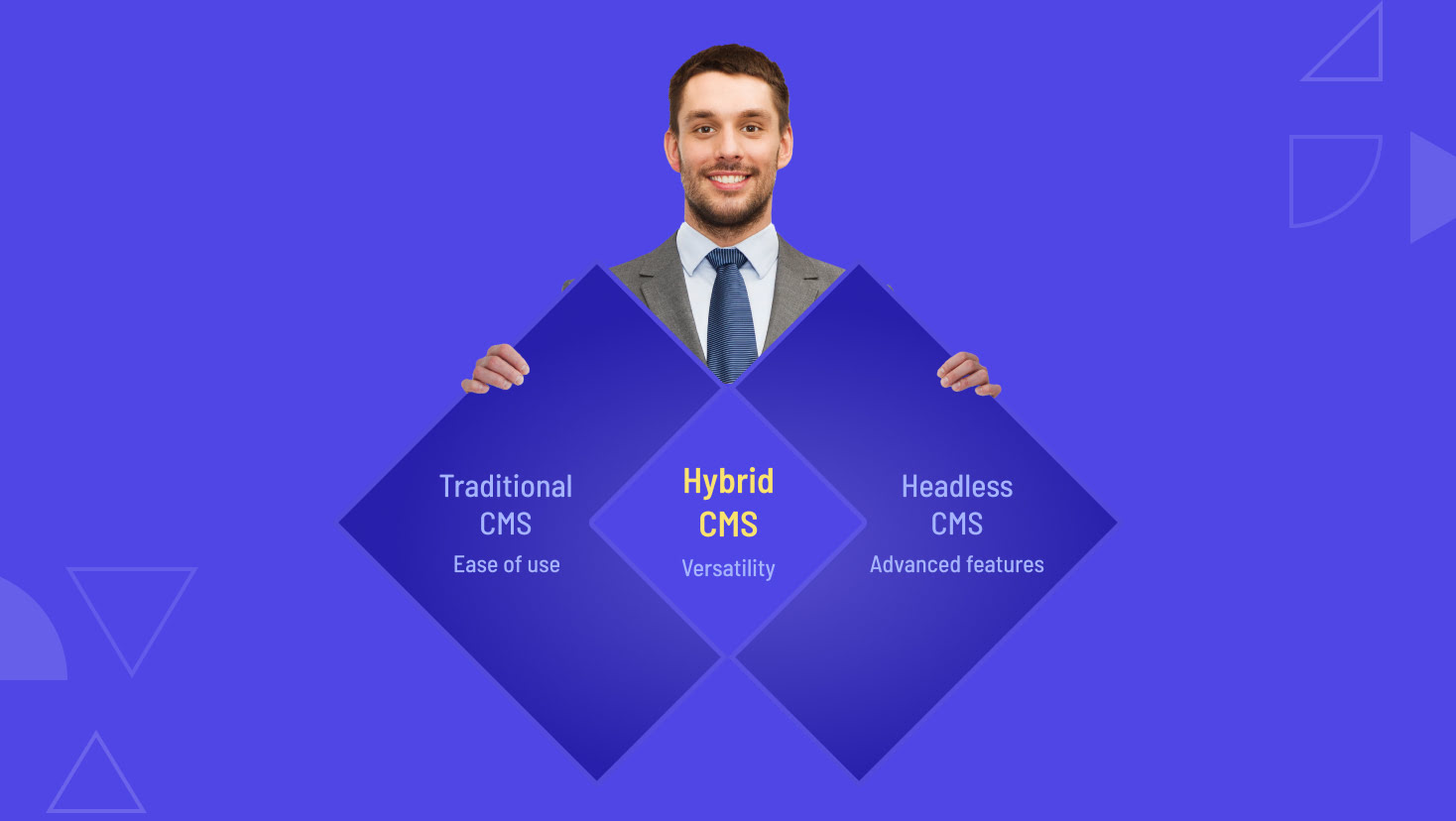
What’s Inside
- Traditional CMS – Ease of Use but Lack of Customization
- Headless CMS – Solution to Legacy CMS Drawbacks
- Hybrid CMS – Best of Both Worlds
- 5 Key Benefits of Hybrid CMS
- What Will You Get from Integrating with Experro?
- Overcome the Limitations of Your Existing Tech Stack
- Concluding Thoughts
Key Takeaways
- Hybrid CMS offers organizations the benefits of both traditional and headless CMS.
- It provides a scalable solution with a perfect blend of user-friendliness, flexibility and omnichannel content delivery.
- With the hybrid approach, organizations can retain their existing tech stack while reaping the benefits of the transformative features of headless CMS.
While traditional CMS offers ease of use, it falls short of fulfilling the changing customer needs and dynamic demands of the modern landscape. Undoubtedly, a headless content management system is a perfect solution to the limitations of traditional CMS.
However, the question remains: How do traditional CMS owners adopt the advanced features of a headless CMS without losing their existing tech stack?
The answer lies in adopting a hybrid CMS approach.
It offers the advantage of integrating with advanced features of headless CMS while leveraging the strengths of your existing tech stack. The hybrid approach helps to gradually adopt the new functionality and carefully bridges the gap of old technology.
In this blog, we will shed light on why to choose the hybrid CMS approach and uncover its benefits. Before that, let's explore why there is a need for hybrid architecture.
Traditional CMS – Ease of Use but Lack of Customization
Traditional content management systems have enjoyed widespread popularity due to their ease of use. However, user-friendly interfaces are not merely enough to meet the demands of today's evolving digital landscape. We will tell you why!
Legacy/coupled CMS was great until there was only one point of digital interaction: websites! Fortunately, or unfortunately, only website days are gone.
It's the transformative digital era of social media, mobile apps, voice assistance, and smartwatches. Customers expect seamless interaction on every digital channel.
Imagine the evolution of content management systems parallel to the introduction of smartphones. While old brick phones were straightforward, they became obsolete in the era of smartphones, which offer many features to make people's lives much faster and easier.
Similarly, traditional CMS boasts a user-friendly interface but poses challenges when seamlessly reaching customers on different digital channels. Due to its rigid architecture, the monolithic system often falls short of fulfilling the customer-centric needs. That's where you should know what wins traditional vs headless CMS debate.
However, headless CMS model is undoubtedly the solution to the pitfalls of traditional CMS. So, without further ado, let's find out how.
Headless CMS – Solution to Legacy CMS Drawbacks
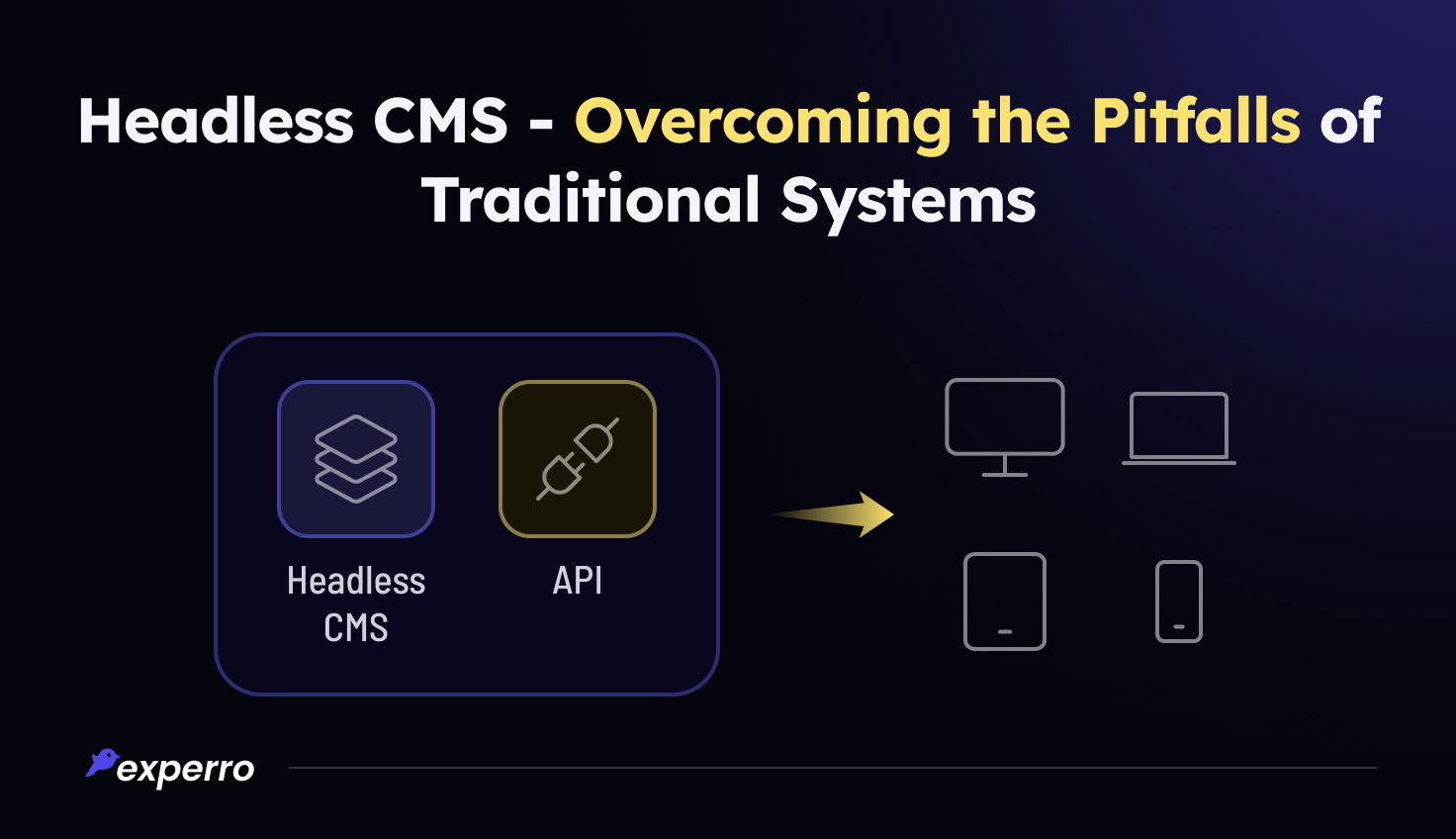
Did you know? A staggering 82.91% of companies reported that switching to headless CMS solutions improved their time, budget, productivity, and revenue. The future of headless CMS is promising due to its flexible architecture.
Despite being a relatively new technology, Headless content management systems architecture can turn your visitors into loyal customers! Getting a deeper understanding about what is headless CMS will convince you about the transformation it can bring to your digital presence.
Businesses opt for a headless CMS model in following situations:
- If they are entering the realm of headless CMS for the first time.
- When there's a need to replace the existing system entirely, with headless CMS migration.
However, what about the traditional CMS owners who don't want to completely replace their existing tech stack? In that case, organizations can adopt hybrid architecture and enjoy the benefits of both systems!
Let's find out what a hybrid content management system is and why it matters.
Hybrid CMS – Best of Both Worlds
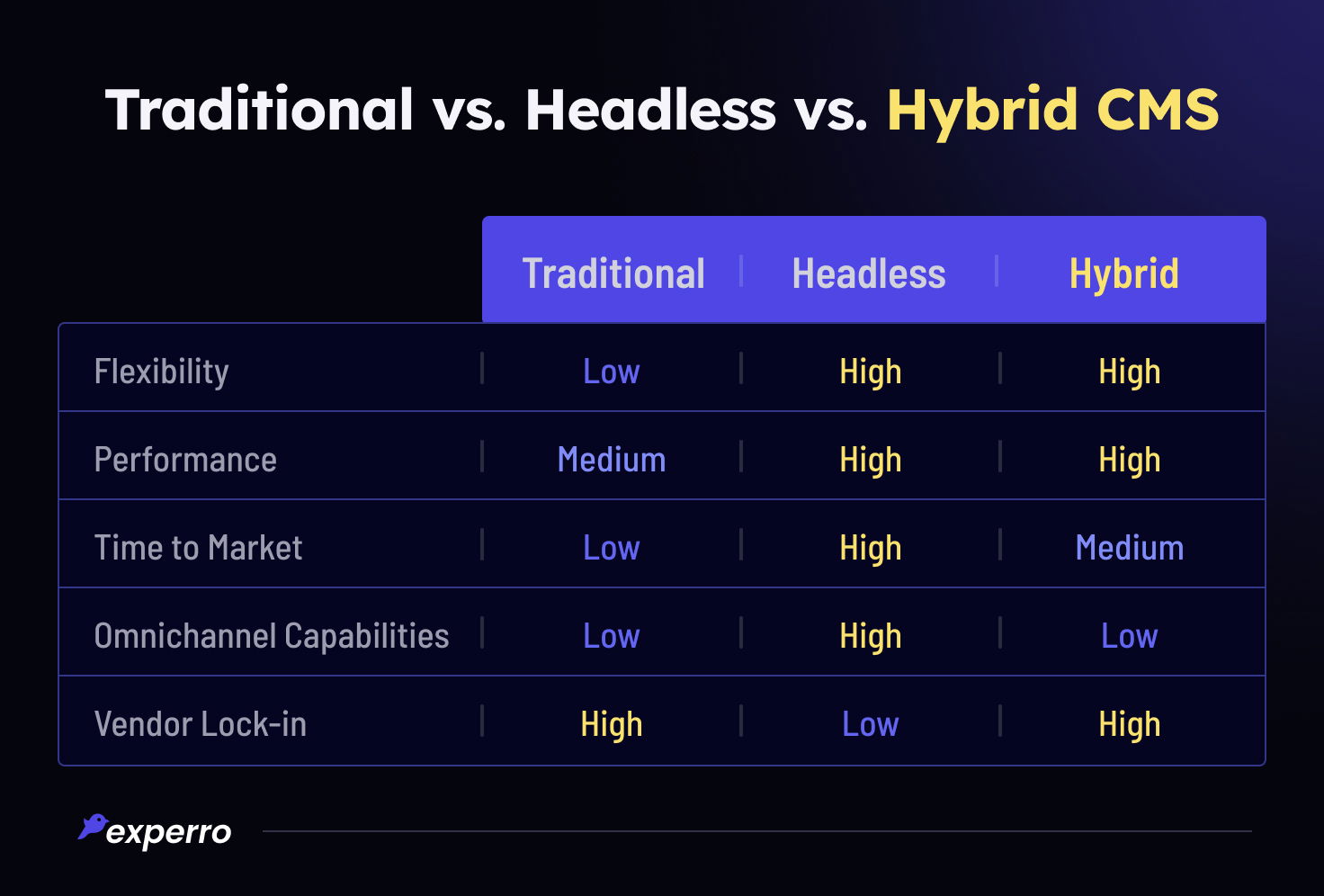
In the report by IDC, Marci Maddox - research vice president of IDC's Content and Digital Experience Strategies program, says:
Organizations are adopting the hybrid CMS model because they want the ease of full stack presentation and flexibility of headless CMS.
A hybrid content management system architecture allows you to integrate your existing tech stack with the best-in-class headless CMS of your choice.
Yes, you heard it right! You don't need to lose your monolithic system to gain the benefits of pure headless CMS. Instead, you can use both systems to get the best results by adopting a hybrid headless CMS. This formula will help you understand how it works.
Hybrid CMS = User-friendliness of legacy CMS + Flexibility and frontend freedom of headless CMS.
Hybrid headless CMS combines elements of both traditional and headless systems. It allows content creators to manage content through a unified backend system, just like in a traditional CMS.
However, it also enables organizations to deliver content through APIs (Application Programming Interfaces) to multiple channels using a headless CMS.
A traditional CMS typically consists of a tightly coupled backend and frontend. Content management and presentation are interdependent here. So, the developers can use the pre-defined frontend templates.
Whereas in headless hybrid CMS, content management and content presentation are separate. Which means, there are no pre-defined frontend templates, but instead, developers can choose any front end delivery layer of their choice and customize it according to the changing customer needs.
Moreover, integration with hybrid architecture allows organizations to deliver content through APIs, making the content scalable and accessible on multiple digital channels. The CMS hybrid system is especially valuable for organizations that want a gradual transition towards the headless system and has a website with many pages and content.
5 Key Benefits of Hybrid CMS
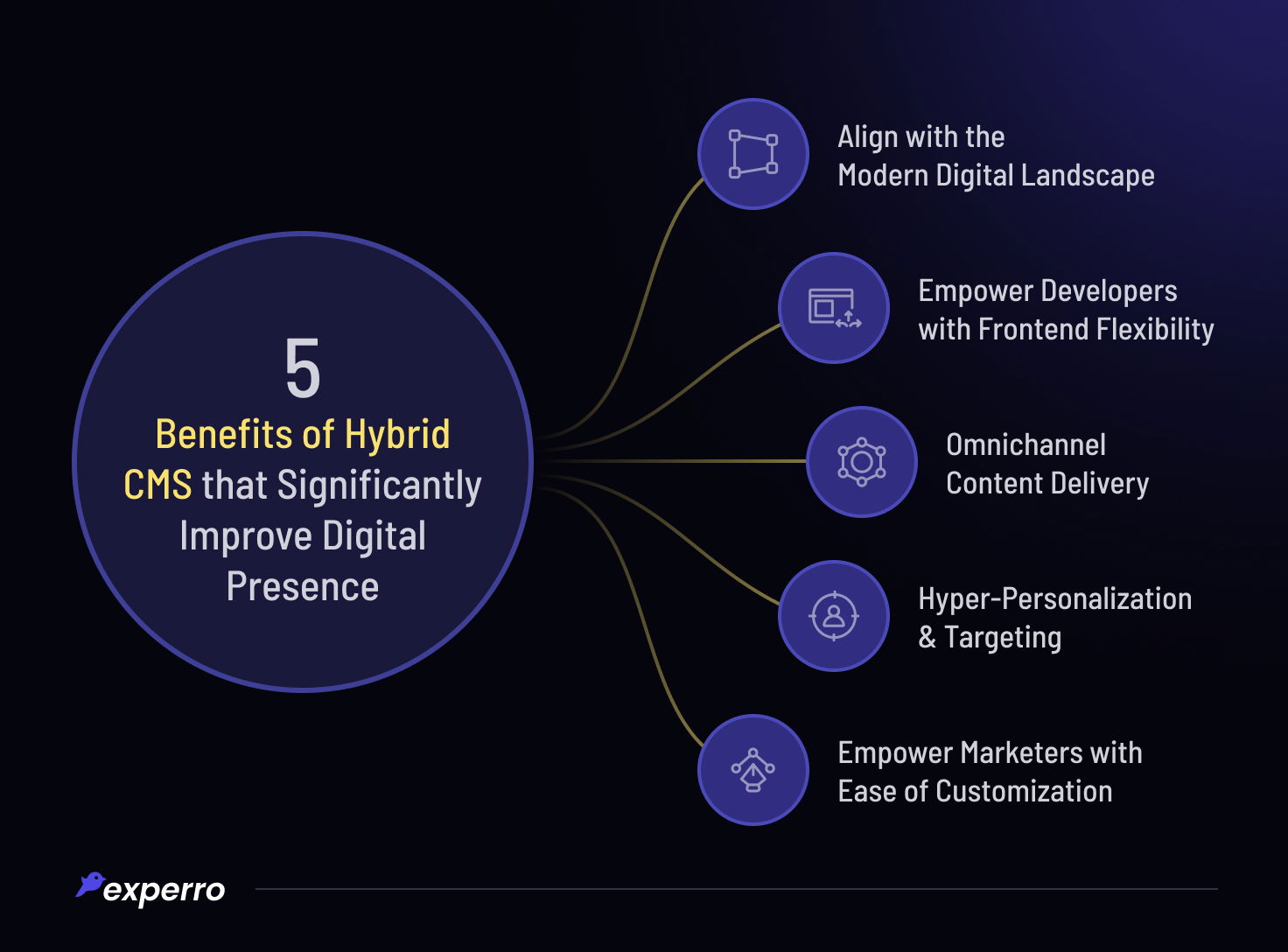
The benefits of hybrid CMS are becoming increasingly popular as it allows organizations to keep their existing tech stack and, at the same time, benefit from the advanced features of headless CMS.
Following are a few benefits of adopting hybrid CMS:
1. Empower Developers with Frontend Flexibility
Monolithic systems have a tight integration of backend and frontend. It has rigid, pre-built frontend templates with limited customization options.
On the other hand, hybrid CMS architecture allows developers the flexibility to choose the frontend of their choice.
Developers can create visually appealing frontend frameworks and customize them according to the changing demand of digital landscape.
2. Empower Marketers
Hybrid architecture empowers marketing teams to manage content effectively. It offers a user-friendly interface and content management capabilities designed for non-technical users.
With the advanced features of content versioning and real time editing marketers can easily update content without the need of developers. Marketers can just drag and drop and rearrange content like puzzle pieces, making the website look perfect. It is as simple as that!
3. Align with the Modern Digital Landscape
Fast content delivery, changing customer needs, omnichannel personalization, and scalability. These are the demands of the modern digital landscape.
Traditional-only CMS falls short of aligning with the changing customer needs due to tightly coupled architecture.
On the other hand, hybrid CMS allows organizations to fulfill these needs and create a seamless digital experience irrespective of channels and devices.
4. Omnichannel Content Delivery
Customers want a seamless experience on each channel. Integrating with headless content management system architecture, organizations can enable seamless content delivery on multiple channels.
Omnichannel content delivery not only improves reach and engagement but also allows you to understand customers behavior better by integrating on different channels.
5. Content Reuse
Hybrid CMS allows you to create content once and reuse it within a website asset. There is no need to repeat content creation. Marketers can reuse the content according to changing business needs.
New season sale? Get it live on your landing page with just a click! Just pick an existing image from your product category page, drag it to the landing page, edit text and personalize it, and you are good to go.
6. Hyper-Personalization and Targeting
In today's digital landscape, hyper personalization is the new battlefield. With the traditional CMS, customization is limited.
However, with hybrid approach organizations can deliver personalized content with the help of easy customization and advanced tools of headless CMS.
Tools such as analytics and SEO tools allow us to gain insights into user behavior, preferences and content performance. It significantly improves the ability to deliver relevant content to the target market.
What Will You Get from Integrating with Experro?
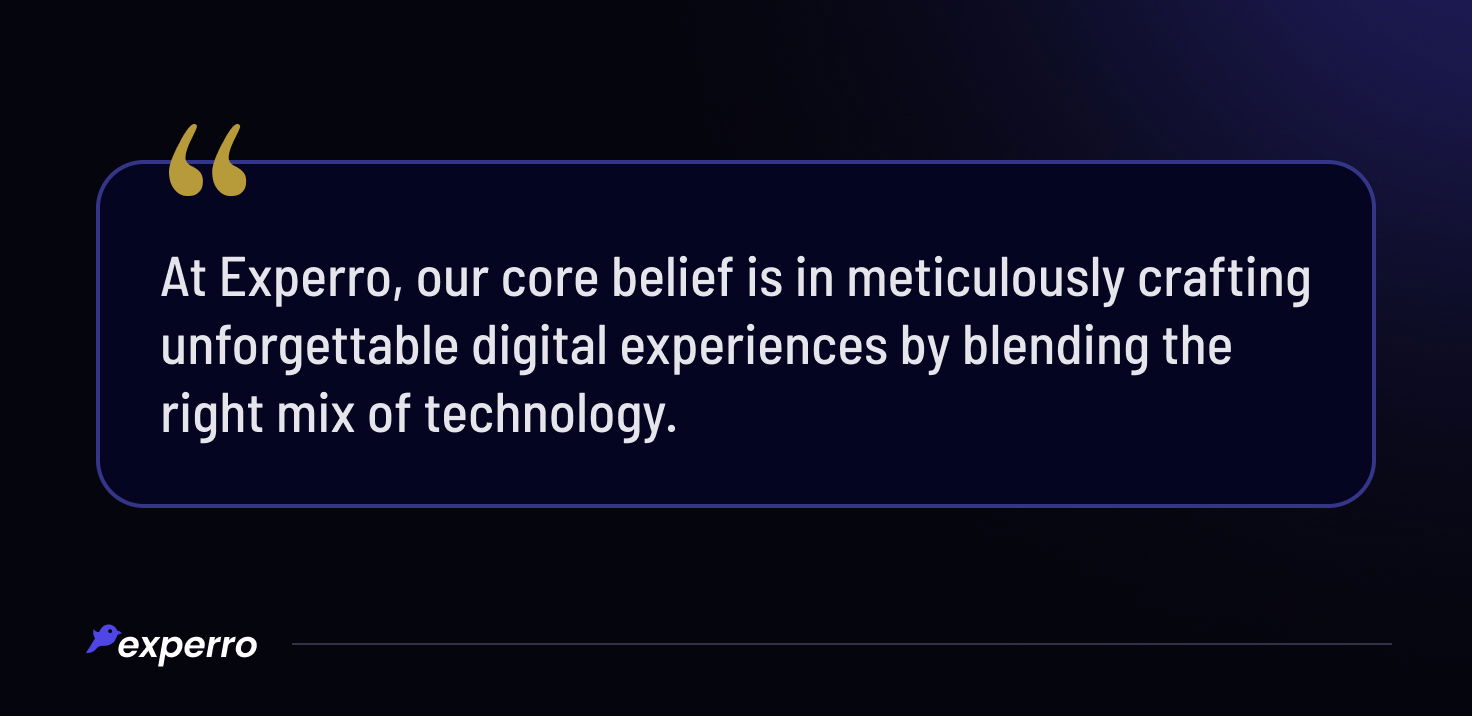
Although Experro headless CMS offers numerous benefits, down are the key benefits organizations can get after integration:
1. End-to-End Support
Experro believes in end-to-end support. It offers a dedicated team to make your headless CMS integration smooth.
Furthermore, Experro provides 24x7 customer support to ensure your queries are always looked after.
2. Light-Speed Content Delivery and Scalability
Experro's API (Application Programming Interface) driven content delivery makes website scalable. That means your website faces no downtime, even on days of a surge in traffic.
Moreover, API-driven content delivery enables delivering seamless content on multiple digital channels.
3. Preview Experiences
With real-time content editing and preview of Experro's headless CMS organizations can see how their content will appear to users before publishing it.
The content preview allows marketers to preview different content types and layouts within the context of website structure.
Here, you control how your content appears in front of your target audience!
4. AI-Powered Search
A total of 83% of the companies say that AI is the top priority in their business plan. Experro has your back to ensure you utilize AI to leverage the best results. Its AI-powered search enhances users' search experiences by presenting the right product they seek.
5. Role-Based Access Control
Organizations can simplify content management with Experro headless CMS role-based access control feature. RBAC ensures that companies' sensitive data and resources are only accessible by authorized persons, not everyone.
Concluding Thoughts
Ultimately, choosing hybrid CMS or fully adopting pure play headless CMS depends on your organization's goals and future requirements.
We believe that organizations should carefully analyze their needs to fully adopt headless CMS or hybrid CMS to make an informed decision.
Experro aims to create a memorable shopping experience with advanced features and a customer-centric approach. However, don't believe what we say; instead, discover the power of headless CMS yourself. Book a demo with our experts today!
FAQs


Priya Zala
21 June 2024Through her writing, she has a lovely way of capturing users' pain points and delivering solution-oriented content. Her writing is sure to captivate readers and leave them with a lasting impression. When not crafting content, Priya enjoys getting lost in a good work of fiction, which soothes her soul.